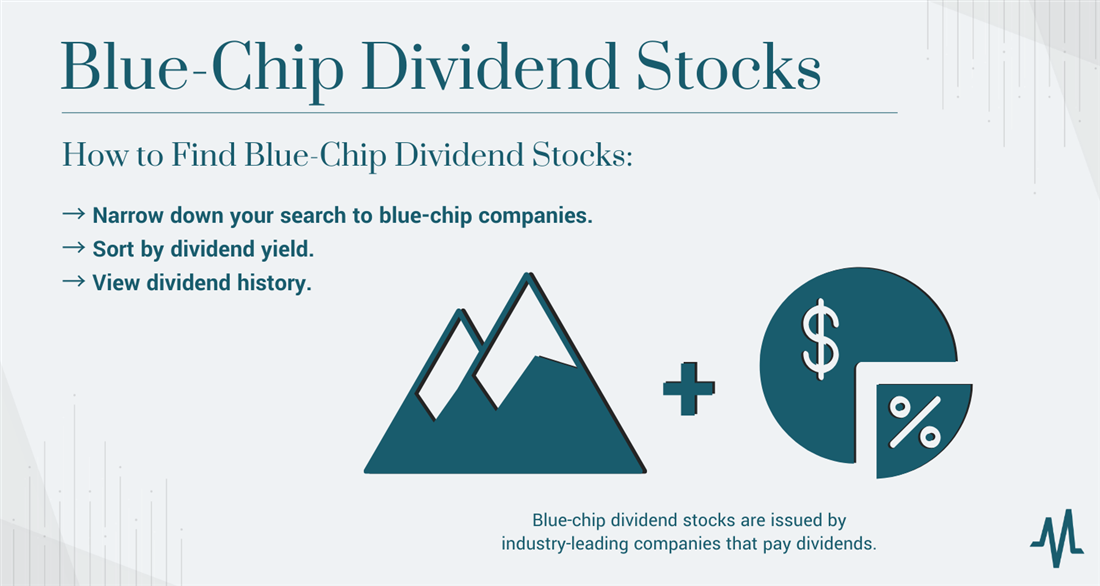Blue chip dividend stocks are stocks issued by financially sound, internationally recognized companies that pay dividends. These dividends may be more consistent and stable when compared to smaller companies, thanks to the financial reputation of the corporation issuing them. You can find dividend blue chip stocks using a stock screener, comparing dividend yield rates and considering the overall market capitalization of the companies you invest in.
While not all blue-chip companies pay a dividend, those that do offer the financial power of industry-leading corporations. This means that these companies are often able to keep paying dividends consistently or even increase their dividends over time. Read on to learn more about how you can identify blue-chip companies and add the power of dividends to your portfolio.
What Are Blue-Chip Dividend Stocks?
What are blue chip dividend stocks? Before answering this question, it's important to know what distinguishes a blue-chip company from less established competitors.
Blue-chip stocks are shares issued by nationally recognized market leaders. To be considered a blue-chip stock, a company must have a long and consistent history operating within its industry and a solid financial record. The term "blue chip" refers to the game of poker, where players who collect the most blue chips see the highest profit. View a list of blue-chip stocks.
A blue-chip dividend stock is a company that meets the criteria to be considered a blue-chip company and that issues a regular dividend. A dividend is a shared portion of a company's profit distributed to investors. Investors value dividends because stocks that pay dividends can create a simple avenue to generating passive income. Investors may also reinvest these dividends into the stock using their broker's DRIP feature, compounding returns and increasing their dividend distributions.
Do all blue chips pay dividends? Unfortunately, the answer is "no." Many new investors are surprised to learn that major blue-chip stocks like Amazon.com Inc. (NASDAQ: AMZN) do not pay dividends despite record-breaking profits. It is essential to know what blue chip stocks pay dividends and how to research them.

How to Find Blue-Chip Dividend Stocks
Ready to learn how to invest in blue chip stocks? Use the following steps to begin your research and start investing.
Step 1: Narrow down your search to blue-chip companies.
While many stocks pay dividends, you'll only benefit from investing in blue-chip companies if you begin your search by market cap. MarketBeat offers a complete blue-chip stock list here, but you may also want to explore major companies using a stock screener that screens dividends. If this is your first time investing, you might want to begin your search by checking out companies that you recognize.
Step 2: Sort by dividend yield.
A stock's dividend yield is a percentage measurement that compares a company's dividend distributions to its share price. Dividend yields are displayed as percentages, which tell you what percentage of a stock's current share price the company pays out each year in total annual dividends.
For example, American Express Co. (NYSE: AXP) is a blue-chip company in the financial services sector. American Express currently pays an annual dividend of $2.08, which gives AXP a dividend yield of 1.20% at the current market price at the time of publication, $173 per share. Consider the dividend yield displayed on each stock's page to understand better what you might expect in returns on your initial investment. Be wary of stocks with dividend yields above 10%, as this may indicate that the company may not be able to continue paying its dividend.
Step 3: View dividend history.
One major benefit of investing in blue-chip companies is that these investments tend to hold value more consistently over time. Before finishing the process of selecting a blue-chip investment, take a look at the company's dividend distribution history.
The best dividend stocks work to keep dividends proportional to the company's changing profits. Ideally, you should invest in blue-chip companies with a long history of increasing annual dividends year after year. This will help you see a stronger return on your investment through continued dividend reinvestment.
What to Look for in Blue-Chip Dividend Stocks
What makes a share of stock a blue chip? Name recognition in and of itself doesn't make a company a blue-chip investment. The following are a few important characteristics when searching for blue chip dividend growth stocks or value stocks.
- Time in the market: One of the key features of a blue-chip stock is its ability to weather multiple market conditions, providing investors with a more conservative investment in times of recession. Before investing in a company's stock, look at its history and how it has weathered past periods of economic stress. The best blue-chip stocks have survived and even thrived through previous recessions.
- Large market capitalizations: You can calculate a company's total market capitalization by multiplying the total number of outstanding shares by the stock's current share price. Most blue-chip companies have total market capitalizations of at least $10 billion, but some major market movers might have total capitalizations of $200 billion or more.
- Included in a major index: Blue-chip companies typically operate large-scale productions that provide necessary goods and services. This makes them ideal for inclusion in major stock indexes, including the Dow Jones Industrial Average and the S&P 500. If you're interested in exploring new opportunities to invest in blue-chip companies but don't know where to look next, consider researching the companies that make up these major market tracking indexes.
- History of increasing dividends: While all blue-chip companies do not pay out a dividend, those that do focus on increasing dividends annually to maintain investor confidence. If you're looking for long-term investment holds, check when the last time the company increased its dividend was, and aim to incorporate companies with a history of rising dividends into your blue-chip portfolio.
Benefits of Investing in Blue-Chip Dividend Stocks
Owning shares of major corporations can provide investors with a unique level of stability and diversification in their portfolios. The following are some of the most common reasons investors choose to hold stock in blue-chip companies.
Enhanced Stability
Blue-chip companies prove that they deserve a place in the market by showcasing stability and growth for years. The largest blue-chip companies may have corporate histories dating back hundreds of years. They have managed to sustain their market dominance even through recessions and periods of economic hardship. As a result, these stocks typically hold value comparatively well, with fewer fluctuations in price daily.
Consider incorporating multiple blue-chip stocks into your portfolio if you're a long-term investor. New companies tend to show more price fluctuations. While this leads to more investor opportunities for returns, it can also mean compounded losses. Even if the market is down when you reach retirement or finally save enough to meet a major investing goal, you're unlikely to see a significant loss within your blue-chip investments.
Stable Dividend Distributions
Very few companies are required to pay out a dividend to investors. Even if a company currently offers dividends, it can adjust its distributions at any time, and there is rarely a guarantee of future returns. This can lead to a "dividend trap," in which a company institutes a high, unsustainable dividend to attract new investors, only to sharply cut the dividend before the next payment.
Developing your passive income strategy using blue-chip dividends makes you less likely to fall into a dividend trap. Blue-chip companies may not show the highest dividend yields you'll see, but they offer stability that makes a dividend trap unlikely. Companies with decades-long history also benefit from offering plenty of research materials.
Before investing in a blue-chip company, look at its dividend history to understand when to expect distributions and how the dividend has changed over time. Most blue-chip companies that offer dividends aim to increase their dividends each quarter.
High Liquidity
If you're investing through a taxable brokerage account, you might want to keep your investments liquid. Highly liquid investments can be bought and sold easily, meaning you can keep liquid investments instead of an emergency fund, cashing out if you run into an unexpected bill.
Blue-chip stocks are highly liquid, as most qualifying companies show average daily trading volumes of a million shares or more. As these investments are always in demand, you can find a buyer if you need to withdraw cash from your account.
Building Passive Income Through Blue-Chip Investments
While many blue-chip stocks show long histories of stable prices, this does not mean they are immune from loss. Even long-term investors should be aware of the risks of investing in individual companies, diversifying their holdings to avoid sudden sharp losses. Additional ways to diversify include supplementing your blue-chip investments with value stocks and major index funds. As is always the case with investing, never put more money into a potentially passive income stream than you can comfortably afford to lose.
FAQs
Still have questions about blue-chip dividend stocks? Let’s take a look at some answers.
What are blue-chip stocks and how do they relate to dividends?
Blue-chip stocks are stocks issued by large companies providing essential goods and services that have weathered various economic conditions. These companies commonly have stable cash flow to incentivize investors to hold the stock and continue investing. Many investors consider blue-chip stocks a path to passive income through dividends.
What are the five highest-paying dividend blue chips?
IBM, Verizon, AT&T, Blackstone and Intel are all blue-chip companies with high dividend yields above 5%. Note that the stock paying the highest dividend may change as the market shifts.
What blue-chip stock has the highest dividend?
IBM's common stock currently features a dividend yield of 5.05%. This comes out to about $1.65 per share owned each quarter.





